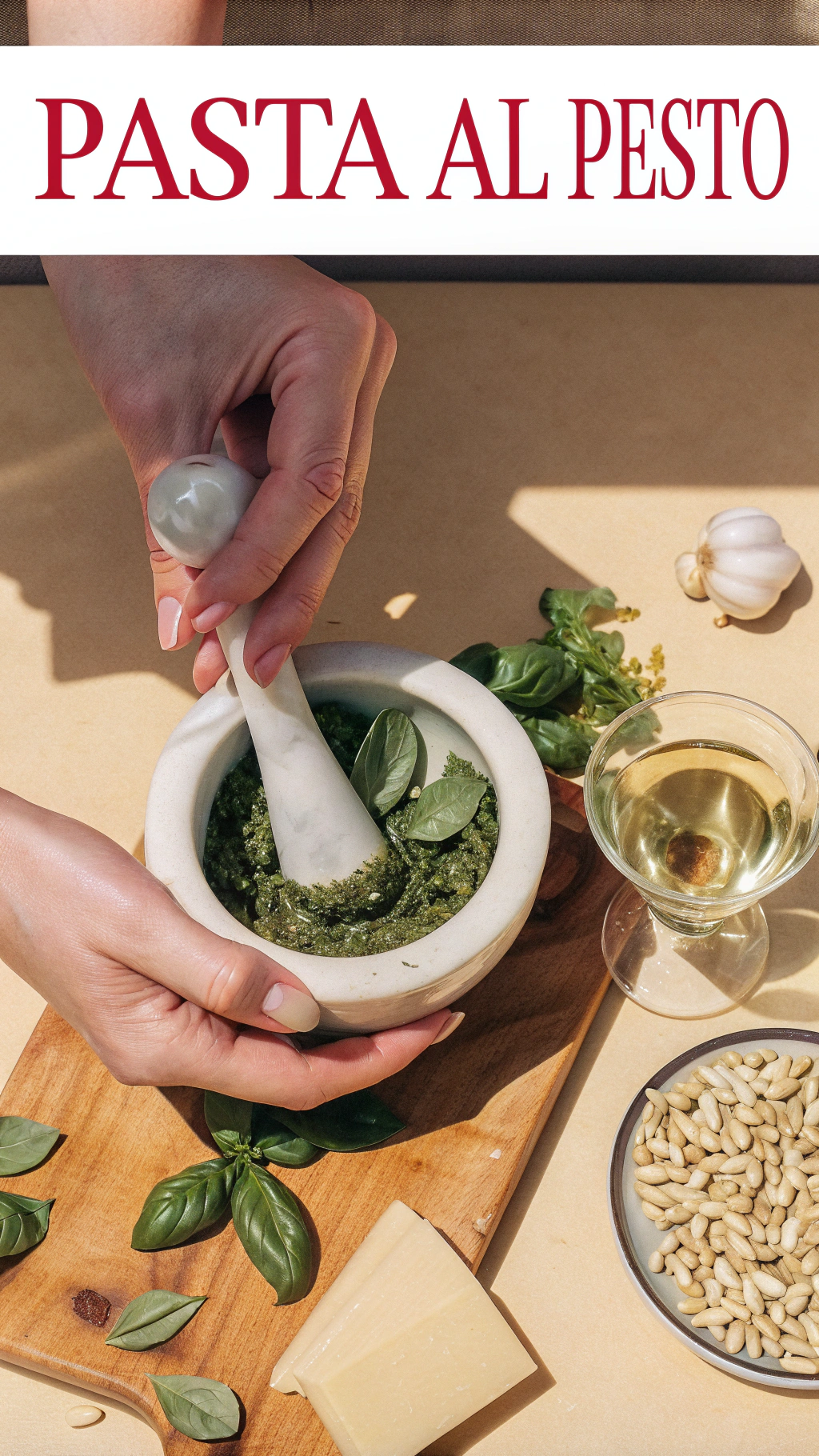The aroma of fresh basil and garlic wafts through the kitchen, instantly transporting me back to sun-drenched afternoons in Liguria. As a French-American chef, I’ve always been captivated by the simplicity and boldness of Italian cuisine, and pasta al pesto embodies this perfectly. Today, I’m excited to share my take on this classic dish, blending traditional techniques with modern twists that will elevate your pasta game to new heights.
The Story Behind Pasta al Pesto
Pesto, derived from the Genoese word “pestâ” meaning “to pound” or “to crush,” has roots dating back to the Roman era. However, the pesto we know and love today originated in Genoa, the capital of Liguria, in the 16th century. This verdant sauce was born out of necessity, as a way to preserve basil with olive oil, garlic, and cheese.
My first encounter with authentic pasta al pesto was during a culinary pilgrimage to Genoa. I was struck by how the locals revered this simple sauce, treating it almost as a sacred art form. The key, I learned, was in the quality of ingredients and the technique of hand-pounding the pesto in a marble mortar with a wooden pestle.
Essential Ingredients Guide
To create an exceptional pasta al pesto, you’ll need:
- 400g long pasta (fusilli lunghi or linguine)
- 2 cups fresh basil leaves
- 1/2 cup extra virgin olive oil (preferably Ligurian)
- 1/4 cup pine nuts
- 2 cloves garlic
- 1/2 cup freshly grated Parmigiano-Reggiano
- 1/4 cup freshly grated Pecorino Sardo
- Coarse sea salt
Pro Tip: For an authentic touch, seek out Basilico Genovese DOP, a protected variety of basil grown in Liguria. Its sweet, delicate flavor is unparalleled.
Kitchen Equipment Checklist
- Large pot for boiling pasta
- Marble mortar and wooden pestle (or food processor)
- Sharp knife and cutting board
- Cheese grater
- Large mixing bowl
While a food processor can be used in a pinch, I strongly recommend investing in a mortar and pestle for the most authentic texture and flavor release.
Step-by-Step Instructions
1. Bring a large pot of salted water to a boil. Cook pasta according to package instructions until al dente.
2. While the pasta cooks, prepare the pesto. If using a mortar and pestle, start by crushing the garlic and a pinch of coarse salt into a paste.
3. Add the pine nuts and continue grinding until smooth.
4. Gradually add the basil leaves, working in batches. Crush and grind the leaves against the sides of the mortar, rotating it as you go.
5. Once all the basil is incorporated, slowly drizzle in the olive oil while continuing to grind.
6. Add the grated cheeses and mix until well combined.
7. Reserve 1 cup of pasta cooking water before draining the pasta.
8. In a large mixing bowl, combine the hot pasta with the pesto, adding small amounts of reserved pasta water as needed to create a creamy consistency.
9. Serve immediately, garnished with extra grated cheese and a few basil leaves.
Chef’s Secret Techniques
The key to exceptional pasta al pesto lies in the details. Here are some pro tips to elevate your dish:
1. Blanch the basil leaves for 5 seconds in boiling water, then shock in ice water. This preserves their vibrant color and prevents oxidation.
2. Toast the pine nuts lightly before adding them to the pesto for a nuttier flavor. This technique also works wonders when grilling other ingredients.
3. Add a squeeze of lemon juice to brighten the flavors and prevent browning.
4. For a creamier texture, emulsify the pesto by slowly drizzling in the olive oil while continuously stirring.
Common Pitfalls and Solutions
1. Bitter Pesto: This is often caused by overworking the basil. Use a sharp knife when cutting, and avoid over-processing.
2. Watery Sauce: Make sure to thoroughly dry the basil leaves after washing. Add pasta water gradually to achieve the desired consistency.
3. Dull Color: Blanching the basil briefly helps maintain its vibrant green color.
Serving & Presentation Tips
For a stunning presentation, toss the pasta with most of the pesto, reserving a small amount to dollop on top. Garnish with a sprinkle of pine nuts, a few whole basil leaves, and a light dusting of grated Parmigiano-Reggiano. Serve in warmed bowls to maintain the perfect temperature.
Recipe Variations & Adaptations
1. Sicilian-Style: Add sun-dried tomatoes and replace pine nuts with almonds for a unique twist.
2. Vegan Version: Substitute nutritional yeast for the cheese and increase the pine nuts for added richness.
3. Gluten-Free: Use your favorite gluten-free pasta. I recommend a corn-based variety for its similar texture to wheat pasta.
4. Winter Pesto: When basil isn’t in season, try using kale or arugula for a different but equally delicious pesto.
Wine Pairing & Serving Suggestions
Pasta al pesto pairs beautifully with a crisp, mineral-driven white wine like Vermentino from Liguria or a light-bodied Pinot Grigio from Friuli. For a red option, try a young, unoaked Barbera d’Asti.
Serve alongside a simple green salad dressed with lemon and olive oil, or some lemon chicken for a heartier meal.
Storage & Reheating Guide
Store leftover pasta al pesto in an airtight container in the refrigerator for up to 3 days. When reheating, add a splash of water or olive oil to revive the sauce. Gently warm over low heat, stirring frequently to prevent sticking.
For make-ahead convenience, prepare the pesto separately and freeze in ice cube trays. Thaw as needed and toss with freshly cooked pasta.
Pasta al pesto is more than just a dish; it’s a celebration of simplicity, freshness, and tradition. By mastering this recipe, you’re not only creating a delicious meal but also connecting with centuries of Italian culinary heritage. So, roll up your sleeves, grab your mortar and pestle, and let’s bring a taste of Liguria to your kitchen. Buon appetito!
